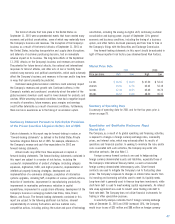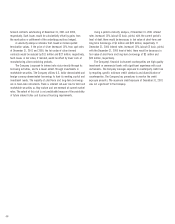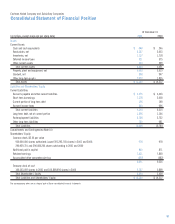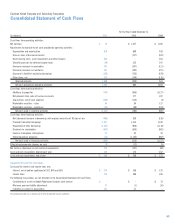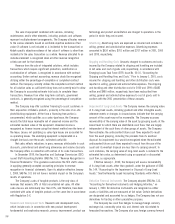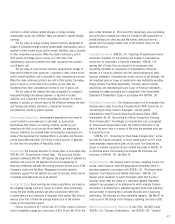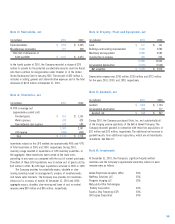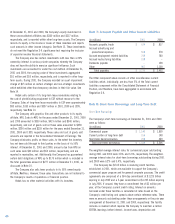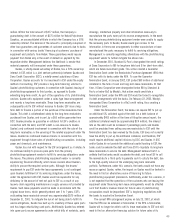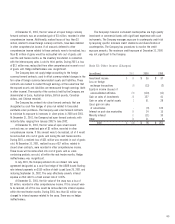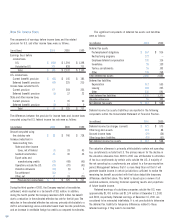Kodak 2001 Annual Report Download - page 58
Download and view the complete annual report
Please find page 58 of the 2001 Kodak annual report below. You can navigate through the pages in the report by either clicking on the pages listed below, or by using the keyword search tool below to find specific information within the annual report.
56
The sale of equipment combined with services, including
maintenance, and/or other elements, including products and software,
represent multiple element arrangements. The Company allocates revenue
to the various elements based on verifiable objective evidence of fair
value (if software is not included or is incidental to the transaction) or
Kodak-specific objective evidence of fair value if software is other than
incidental to the sales transaction as a whole. Revenue allocated to an
individual element is recognized when all other revenue recognition
criteria are met for that element.
Revenue from the sale of integrated solutions, which includes
transactions which require significant production, modification or
customization of software, is recognized in accordance with contract
accounting. Under contract accounting, revenue should be recognized
utilizing either the percentage-of-completion or completed-contract
method. The Company currently utilizes the completed-contract method
for all solution sales as sufficient history does not currently exist to allow
the Company to accurately estimate total costs to complete these
transactions. Revenue from other long-term contracts, government
contracts, is generally recognized using the percentage-of-completion
method.
The Company may offer customer financing to assist customers in
their acquisition of Kodak’s products, primarily in the area of on-site
photofinishing equipment. At the time a financing transaction is
consummated, which qualifies as a sales-type lease, the Company
records the total lease receivable net of unearned income and the
estimated residual value of the equipment. Unearned income is
recognized as finance income using the interest method over the term of
the lease. Leases not qualifying as sales-type leases are accounted for
as operating leases. The underlying equipment is depreciated on a
straight-line basis over the assets’ estimated useful life.
Net sales reflects reductions in gross revenues attributable to cash
discounts, promotional and advertising allowances and volume discounts
the Company offers in connection with certain of its sales transactions.
In December 1999, the Securities and Exchange Commission (SEC)
issued Staff Accounting Bulletin (SAB) No. 101, “Revenue Recognition in
Financial Statements.” This guidance summarizes the SEC staff’s views
in applying generally accepted accounting principles to revenue
recognition in financial statements. Upon its adoption effective January
1, 2000, SAB No. 101 did not have a material impact on the Company’s
results of operations.
The Company’s sales of tangible products is the only class of
revenues that exceeds 10% of total consolidated net sales. All other
sales classes are individually less than 10%, and therefore, have been
combined with sales of tangible products on the same line in accordance
with Regulation S-X.
Research and Development Costs Research and development costs,
which include costs in connection with new product development,
fundamental and exploratory research, process improvement, product use
technology and product accreditation are charged to operations in the
period in which they are incurred.
Advertising Advertising costs are expensed as incurred and included in
selling, general and administrative expenses. Advertising expenses
amounted to $634 million, $701 million and $717 million in 2001, 2000
and 1999, respectively.
Shipping and Handling Costs Amounts charged to customers and costs
incurred by the Company related to shipping and handling are included
in net sales and cost of goods sold, respectively, in accordance with
Emerging Issues Task Force (EITF) Issue No. 00-10, “Accounting for
Shipping and Handling Fees and Costs.” Prior to January 1, 2001, costs
incurred for shipping and handling and other distribution costs were
reported in selling, general and administrative expenses. The shipping
and handling and other distribution costs for 2000 and 1999 of $482
million and $480 million, respectively, have been reclassified from
selling, general and administrative expenses to cost of goods sold to
conform with the 2001 presentation of these amounts.
Impairment of Long-Lived Assets The Company reviews the carrying value
of its long-lived assets, including goodwill and other intangible assets,
whenever events or changes in circumstances indicate that the carrying
amount of the asset may not be recoverable. The Company assesses
recoverability of the carrying value of the asset by grouping assets at the
lowest level for which there are identifiable cash flows that are largely
independent of the cash flows of other groups of assets. The Company
then estimates the undiscounted future cash flows expected to result
from the asset grouping, including the proceeds from its eventual
disposal. An impairment loss would be recognized when the estimated
undiscounted future cash flows expected to result from the use of the
asset and its eventual disposal are less than its carrying amount. In
such instances, the carrying value of long-lived assets is reduced to the
estimated fair value, as determined using an appraisal or discounted
cash flow, as appropriate.
Effective January 1, 2002, the Company will assess recoverability
of its long-lived assets, other than goodwill, under the guidance of SFAS
No. 144, “Accounting for the Impairment or Disposal of Long-Lived
Assets.” See the Recently Issued Accounting Standards within Note 1.
Derivative Financial Instruments The Company adopted SFAS No. 133,
“Accounting for Derivative Instruments and Hedging Activities,” on
January 1, 2000. All derivative instruments are recognized as either
assets or liabilities and are measured at fair value. Certain derivatives
are designated and accounted for as hedges. The Company does not use
derivatives for trading or other speculative purposes.
The Company has cash flow hedges to manage foreign currency
exchange risk, commodity price risk, and interest rate risk related to
forecasted transactions. The Company also uses foreign currency forward



